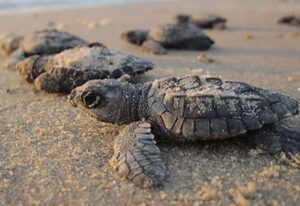Sea turtles, magnificent denizens of the world’s oceans, possess a plethora of fascinating adaptations that allow them to thrive in their marine habitats. While their graceful movements through the water and nesting rituals on sandy shores captivate our attention, the intricacies of their daily life, such as how sea turtles drink water, often remain shrouded in mystery.
In this article, we delve into the remarkable physiological mechanisms that sea turtles employ to quench their thirst in the vast expanse of the ocean.
Here on his page, we will unravel the secrets behind the seemingly simple yet essential act of water consumption in these ancient and captivating marine creatures. How do sea turtles drink water? Let’s dive into the depths of their unique adaptations to unveil the answers.
How do sea turtles drink water?

Sea turtles obtain their water through their food and from the environment in which they live. Unlike humans and some other animals, sea turtles do not have a specialized system for drinking and obtaining freshwater.
The primary source of water for sea turtles comes from the food they eat, which is often marine animals and plants. These prey items contain water, and the metabolic processes of breaking down food contribute to the hydration of the turtle.
Additionally, sea turtles may ingest some seawater unintentionally while feeding or swallowing prey, but they have specialized glands near their eyes that help them excrete excess salt. These salt glands allow sea turtles to eliminate excess salt from their bodies, helping them maintain the proper balance of salts and water.
Importance of understanding how sea turtle drink water
Understanding how sea turtles obtain and manage water is crucial for several reasons:
- Survival and Health: Knowing how sea turtles hydrate themselves is essential for understanding their overall health and survival. Water is fundamental for various physiological processes, and a lack of hydration can lead to health issues and even mortality.
- Conservation Efforts: As many sea turtle species face threats from human activities, habitat loss, pollution, and climate change, understanding their basic biology, including their water intake mechanisms, is vital for effective conservation strategies. Conservationists need this information to create and implement plans that consider the specific needs and behaviors of sea turtles.
- Habitat Management: Knowledge about how sea turtles obtain water can inform habitat management strategies. Protecting and preserving the ecosystems where sea turtles live and ensuring the availability of suitable food sources are critical aspects of conservation.
- Research and Rehabilitation: Researchers and wildlife rehabilitators need to understand the natural behaviors and requirements of sea turtles to better care for them in captivity or during rehabilitation. This knowledge helps create environments that support their well-being and recovery.
- Educational Purposes: Educating the public about sea turtle biology, including how they obtain water, can foster awareness and appreciation for these marine creatures. This understanding is crucial for promoting responsible behavior and conservation efforts among local communities and global audiences.
- Policy Development: Governments and policymakers may use scientific knowledge about sea turtle biology to formulate effective policies and regulations for the protection of these species. This could include establishing marine protected areas, implementing fishing regulations, and addressing other human activities that impact sea turtle populations.


